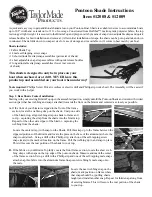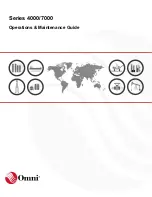
7 von 16
- A worn wire rope must be replaced by a
wire rope with the same dimensions and
the same quality.
Maintenance of the wire rope
At the end of the working day, clean the wire
rope from coarse dirt over its entire length (i.e.
including the part which is in the hoist or in the
load lifting attachment) and slightly regrease
it in order to prevent corrosion.
Inspection of the load hook and top hook
Inspect the hook for deformation, damage,
surface cracks, wear and signs of corrosion,
as required, but at least once a year. Actual
operating conditions may also dictate shorter
inspection intervals.
Hooks that do not fulfi l all requirements must
be replaced immediately. Welding on hooks,
e.g. to compensate for wear or damage is
not permissible. Top and/or load hooks must
be replaced when the mouth of the hook has
opened more than 10 % (Fig. 15) or when the
nominal dimensions have reduced by 5 % as
a result of wear. Nominal dimensions and
wear limits are shown in the following table 2.
If the limit values are exceeded, replace the
components.
Repairs may only be carried out by
authorized specialist workshops that
use original Yale spare parts.
After repairs have been carried out and
after extended periods of non-use, the hoist
must be inspected again before it is put into
service again.
The inspections have to be initiated by
the operating company.
and fully operational and cover the condition
of the unit, suspension, equipment and sup-
porting structure with regard to damage, wear,
corrosion or any other alterations.
Initial operation and recurring inspections
must be documented (e.g. in the CMCO works
certifi cate of compliance).
If required, the results of inspections and
appropriate repairs must be verifi ed. If the
hoist (from 1 t lifting weight) is fi tted on or in
a trolley and the hoist is used to move a lifted
load in one or several directions, the installati-
on is considered to be a crane and the further
inspections must be carried out if applicable.
Paint damage should be touched up in order to
avoid corrosion. All joints and sliding surfaces
should be slightly greased. In the case of heavy
contamination, the unit must be cleaned.
Recommended lubricant
Lubricate the teething (recommended
lubricant: Multi-purpose grease lubricant
DIN 51825 T1 K 2 K).
The unit must be given a general overhaul
after 10 years, at the latest.
In particular, check the dimensions of the
wire rope, the load hook and the top hook.
They must be compared with the dimensions
specifi ed in the table (Tab. 1, Tab. 2).
ATTENTION:
After the replacement of
components, a subsequent inspection by a
competent person is obligatory!
Inspection of the wire rope
- Check the rope for outer defects, deforma-
tions, kinks, broken individual wires or
strands, crushing, swelling, rust damage
(e.g. corrosion marks), strong overheating
and heavy wear of the rope end connections
(e.g. pressure sleeve).
- For safety reasons, wire ropes must be
replaced when the number of broken wires in
the outer strands exceeds a defi ned quantity.
This is counted over a reference length of
rope 11 times or 30 times the rope diameter.
- The wire rope must be replaced immediately,
if a strand is completely broken, the rope is
deformed, kinked, compressed or damaged
or worn in any other way!
- The wire rope must be discarded, if the rope
diameter has reduced on longer sections by
10 % or more compared with the nominal
dimension.
- DIN 15020 sheet 2 “Principles Relating to
Rope Drives; Supervision during Operation”
and the relevant international and national
regulations of the country of use are defi ni-
tive for the maintenance and inspection of
wire ropes.
TRANSPORT, STORAGE, TAKE OUT OF
SERVICE AND DISPOSAL
Observe the following for transporting
the unit:
• Do not drop or throw the unit, always deposit
it carefully.
• Use suitable transport means. These
depend on the local conditions.
Observe the following for storing or tem-
porarily taking the unit out of service:
• Store the unit at a clean and dry place.
• Protect the unit incl. all accessories against
contamination, humidity and damage by
means of a suitable cover.
• Protect hooks against corrosion.
• Protect the rope against corrosion by
greasing.
• Slightly grease the accessible gear wheels.
• If the unit is to be used again after it has
been taken out of service, it must fi rst be
inspected again by a competent person.
Disposal:
After taking the unit out of service, recycle or
dispose of the parts of the unit in accordance
with the legal regulations.
Further information and operating
instructions are to be found at
www.cmco.eu


































